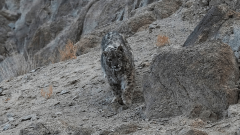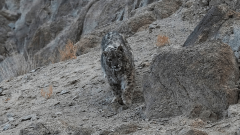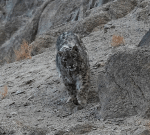
Get the Popular Science daily newsletter💡
Adapted to live in some of our planet’s most inhospitable mountainous regions, snow leopards (Panthera uncia) are the ultimate mountain climbers and an iconic big cat. A recent camera trapping study found that India is home to the most dense population of the black and white carnivores on Earth and most live in a remote northern region of the subcontinent. Here, they also appear to co-exist alongside rural communities, where they are respected by local human populations. The findings are detailed in a study published May 7 in the open-access journal PLOS One.
Snow leopards are found in mountainous regions across 12 Asian countries: Afghanistan, Bhutan, China, India, Kazakhstan, Kyrgyz Republic, Mongolia, Nepal, Pakistan, Russia, Tajikistan, and Uzbekistan. Their signature fur acts as natural camouflage against the snowy mountains, where they prey on a variety of sheep, ibex, hares, marmots, and pika.

In order to effectively conserve this vulnerable species, researchers need solid data on their population size and where they are living. However, the remote and rugged terrain that they call home and their notoriously shy nature makes this difficult.
In this new study, a team from the Department of Wildlife Protection in northern India’s Ladakh Union Territory assessed the snow leopard population across almost 23,000 square miles of landscape. The team started by looking for the tell-tale signs of snow leopards–footprints, scat, and scratch marks. They also surveyed for large carnivores like brown bears and lynx and wild herbivores and livestock.
Next, they set up 956 camera traps along about 3,300 square miles occupied by the snow leopards. These non-invasive cameras are used to help scientists estimate animal populations across territories.
“To photograph snow leopards’ foreheads, we had to make them pose in front of our cameras,” the team wrote in a statement. “This was done by spraying a small amount of perfume just below the cameras that were deployed near their favored scent marking rocks on the high ridge tops. The curious leopards lower their heads to smell the novel smell and we have our prized photos!”

Finally, they used artificial intelligence to analyze the photos and identify individual snow leopards by their distinct patterns of markings on their foreheads. This method called “fingerprinting” uses a special pattern recognition software to look at the spot patterns and store them in a database. This way, scientists can compare it with other snow leopard photos and come up with matches.
“This reduced our






